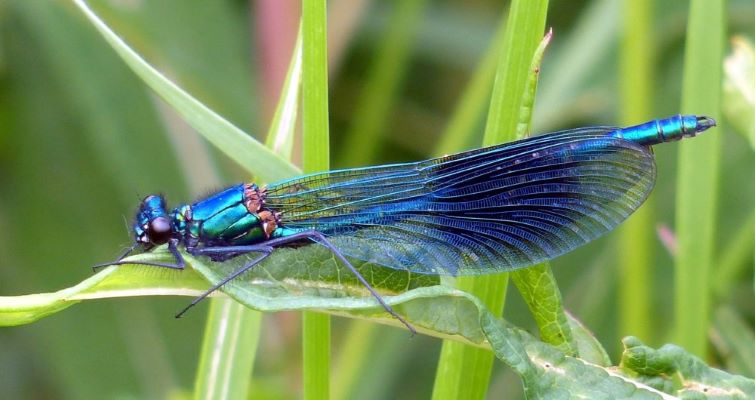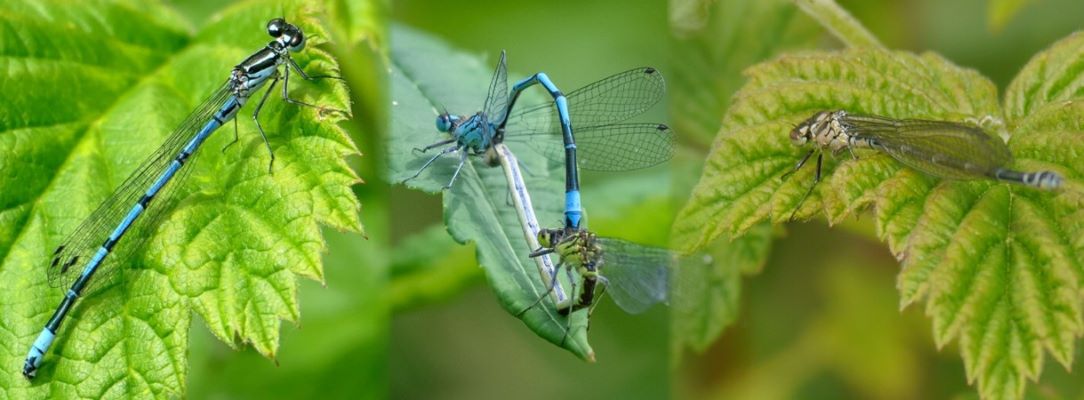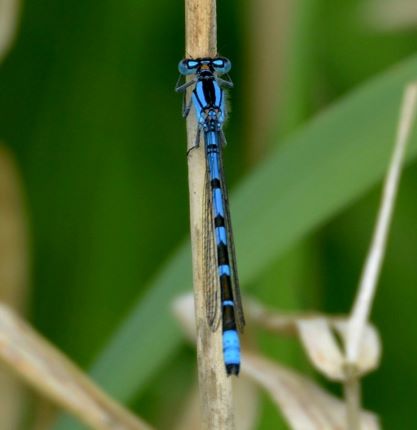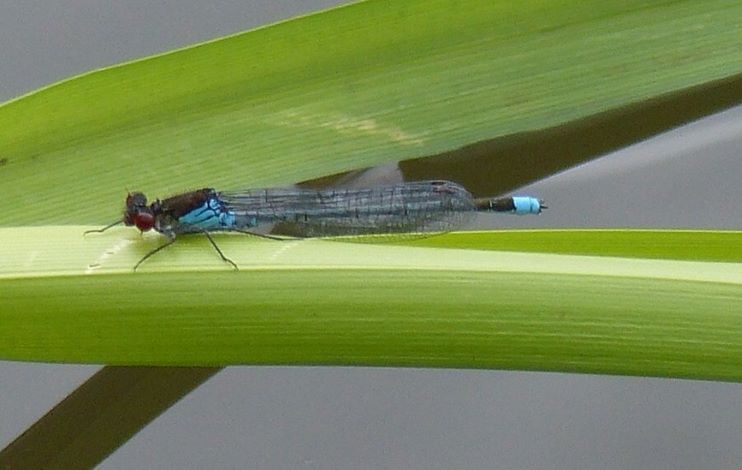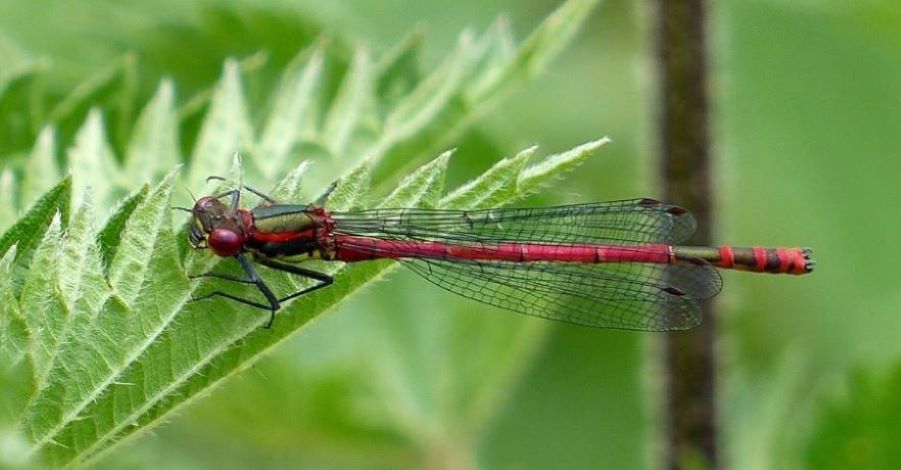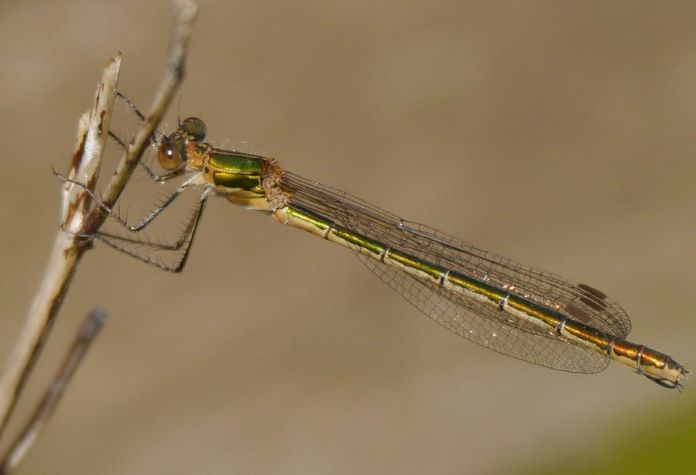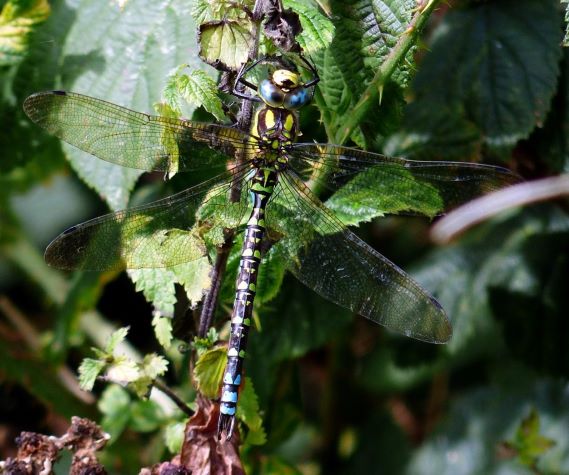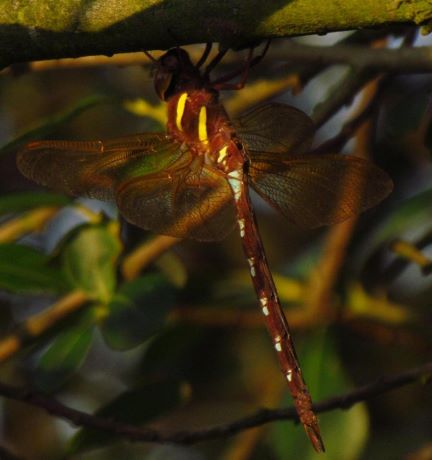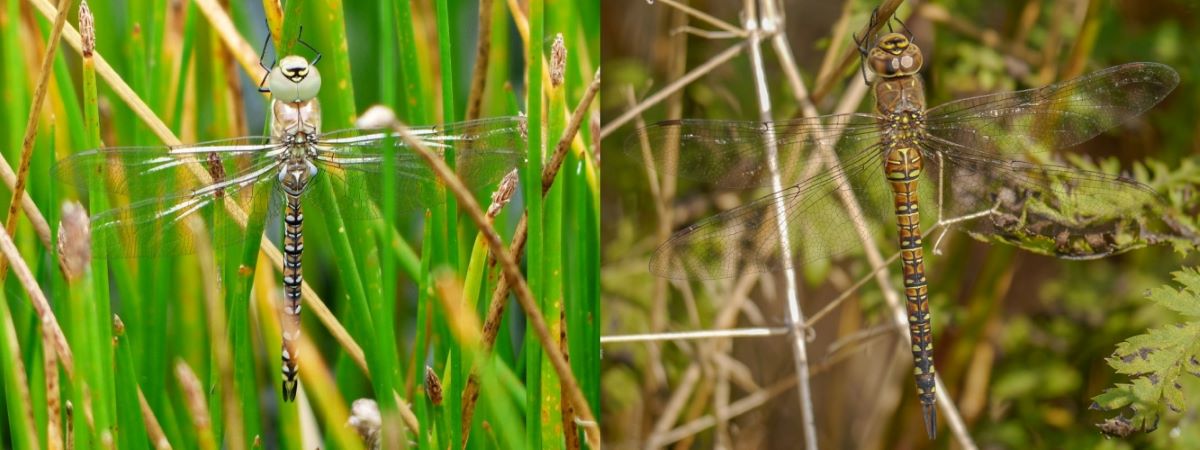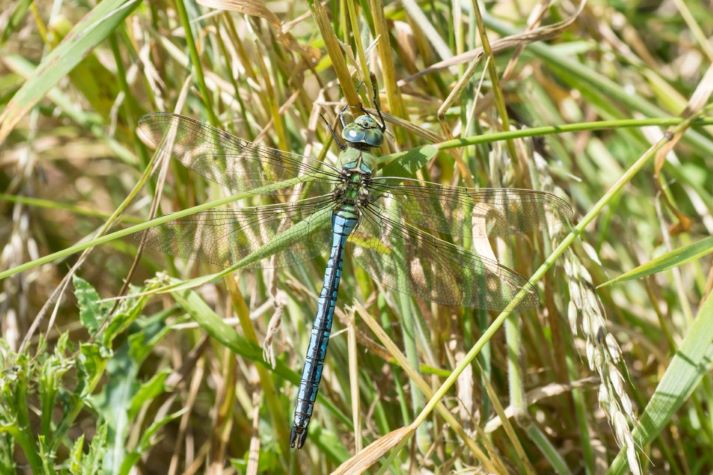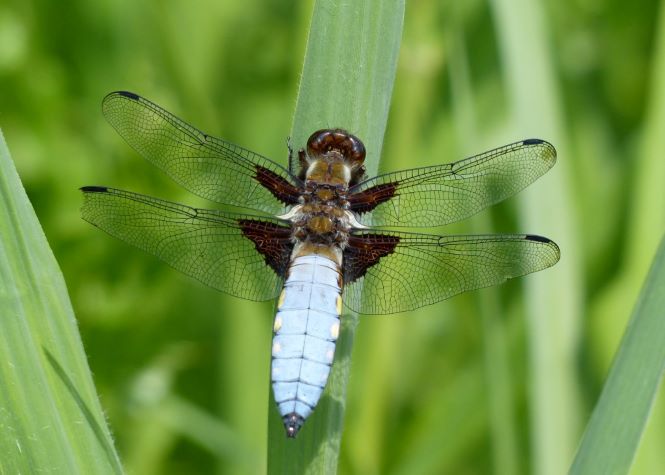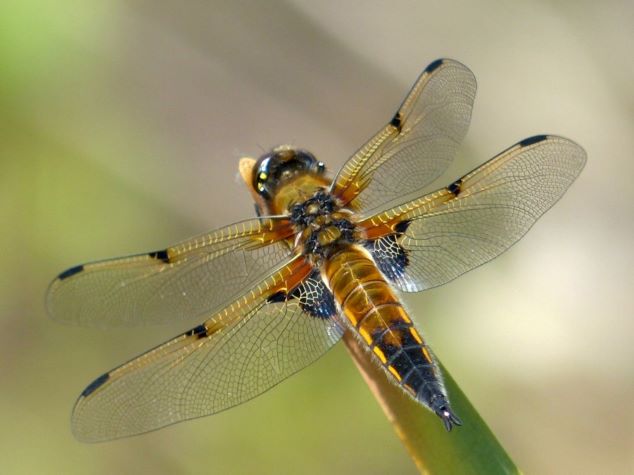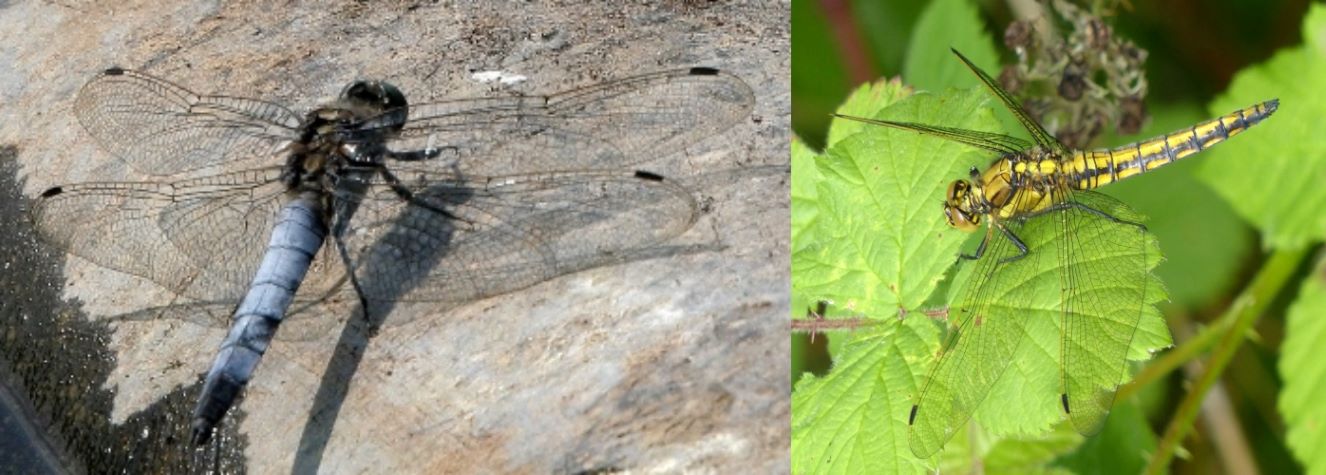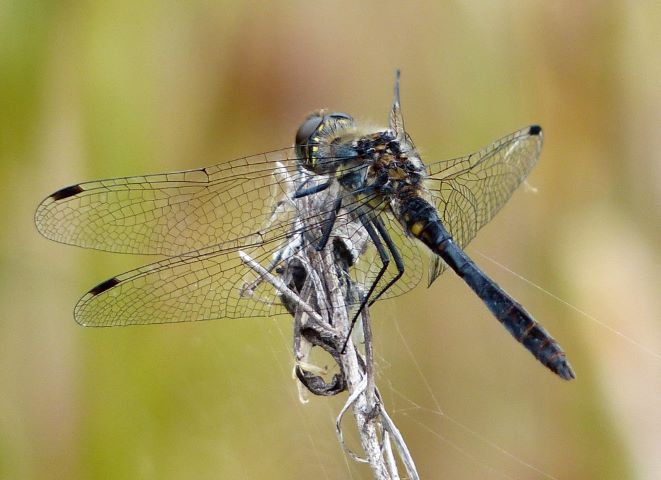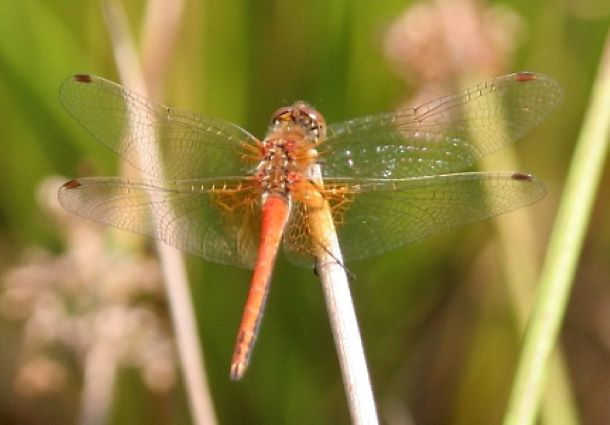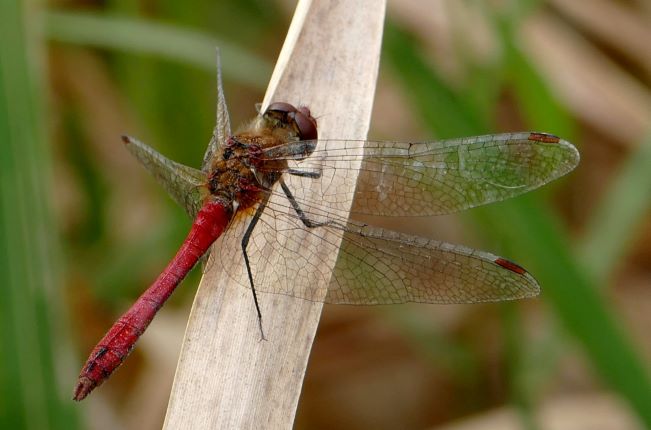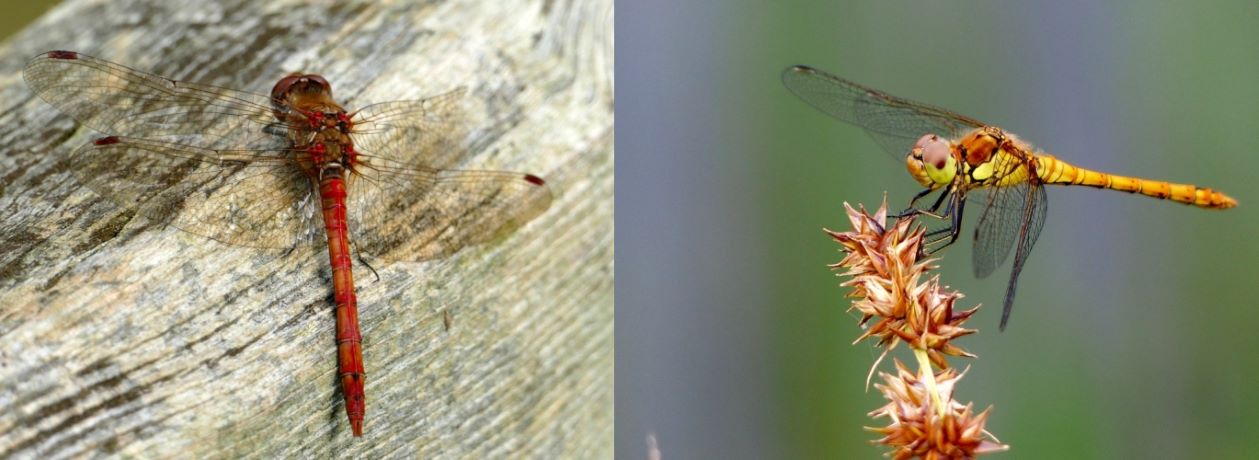Dragonfly & Damselfly Species Recorded At Woolston Eyes
Damselflies are insects classified in the order Odonata and sub-order Zygoptera.
ID tip - Damselflies fold their wings closed along their body when not in flight.
Dragonflies are insects classified in the order Odonata and sub-order Anisoptera.
ID tip – Dragonflies do not fold their wings when not in flight.
Woolston Eyes has recorded 21 species with the majority being recorded annually and are identified below with summary identification notes, status and record photographs were available.
David Bowman a male from No3 Bed
01 Banded Demoiselle (Calopteryx splendens)
Identification - Banded and Beautiful Demoiselle are the only damselfly with coloured wings in the UK. Male Banded Demoiselle have a large dark-blue/black band across the centre of the blue veined wings and a deep blue body colour with metallic green iridescence and similar eye colour. Females have a metallic green body colour, sometimes bronze-green, terminating in a bronze tip. Wings are iridescent pale-amber/green or bronze without the dark centre colour band. Immature males are similar in body colour to mature males but with brownish eyes and the wing band is brown green. Immature females have very pale yellow wings and brown eyes.
Status - There were few records of this species until 2006 but are now frequently seen. Banded Demoiselle are less common than the ‘other blue’ damselfly on the Reserve. Active period generally from May through August.
Left, a mature male on No.3 Bed by David Bowman on 23/05/2015, centre, a mature male and female from No.3 Bed by David Mercer on 11/06/2016 and right, an immature female from No.3 Bed by David Spencer on 19/05/2016.
02 Azure Damselfly (Coenagrion puella)
Identification - Males are predominately blue coloured with blue eyes with thin black rings on the body and have a characteristic ‘U’ shaped black mark on the second segment. Female adults have similar head and thorax markings as males but predominately greenish with thick black separation rings although a pale blue form occurs rather than the vivid blue of the males. They also lack the black ‘U’ shape mark on the second segment. Immatures differ from the adults by both having pale-brown base body colours, more pinkish in the males, with brown eyes which change into the adult colours with maturity.
Status - This distinctive damselfly is common throughout the reserve with an active flight period generally from April through August.
David Bowman No.1 Bed on 28/05/2016
03 Common Blue Damselfly (Enallagma cyathigerum)
Identification - This species has been found to be common on all four beds since recording began in 1986. Similar looking to the Azure Damselfly but in general appears to have more blue than black colouration which is reversed in the Azure Damselfly. It also has a wider blue antehumeral stripe on the thorax than the Azure Damselfly and only one black line below this blue antehumeral stripe. Females can be blue coloured as the male or a dull green/grey colour and can be difficult to separate without attention to finer detail.
Status - Relatively common across the Reserve with an active period is from April through September.
Brian Baird Weir Basin on 01/07/2016
04 Red-eyed Damselfly (Erythromma najas)
Identification The male has a dark grey abdomen with a blue tip and deep red eyes. The thorax is bronze/black in both sexes but the female has small yellowish antehumral lines as well. Mature females have dark black-grey abdomens, from top, greenish underneath, with greenish lines separating the segments.
Status First recorded in 1986 and repeated in 1998 but was probably overlooked until 2006. It is now regularly seen around the Reserve with an active period from April through September.
Left is a mature male from No.1 Bed on 26/05/2016 by David Bowman, centre an immature male form and right an immature female from No.3 Bed both by Andrew Weir on 21/06/2014
05 Blue-tailed Damselfly (Ischnura elegans)
Identification All forms and sexes are predominately dark bodied. Mature males, always have a bright blue spot at the tail, blue stripes on the thorax and blue eyes. Immature males emerge with greenish stripes on the thorax with gradually change to blue. Females are more variable in colour with mature forms ranging from blue like the males to green thorax + brown tail spot and pale brown thorax + blue tail spot. Immature females can have a violet or pinkish thorax both with blue tail spots.
Status Blue-tailed Damselflies are probably the most common species on the Reserve with an active flight period generally from April through September.
Dave Bowman a male from No1 Bed 06/06/2013
06 Large Red Damselfly (Pyrrhosoma nymphula)
Identification The male is a dark red damselfly with black legs and dark bronze coloured thorax. Females exhibit a variety of colour forms varying in the degree of red and black but all have yellowish rings separating the abdomen segments giving a banded appearance. Status The species is present on all four beds usually in small numbers with an active period from April through August.
David spencer a female from No.1 Bed 2014
07 Emerald Damselfly (Lestes sponsa)
Identification The male of this species is metallic green and develops blue colouration, predominately, in the first and last two segments of the abdomen. The female is thicker bodied and lacks any blue colouration. This species typically holds it wings in a ‘V’ shape when at rest and is relatively common on the reserve since the first record in 1990.
Status Relatively common on the Reserve since the first record in 1990 with an active period May to September.
Dave Bowman a male from No3 Bed 09/09/2013
08 Southern Hawker (Aeshan cyanea)
Identification The male usually shows bright green markings on a dark (black) body and blue spots on the abdomen sides except the last body segments which are coloured blue however specimens with all blue markings can occur. The female is brown with bright green markings..
Status Present in small numbers with an active period from April through October.
Gill Dutton a male from No3 Bed 19/08/2013
09 Brown Hawker (Aeshna grandis)
Identification A large dragonfly and historically the most common ‘hawker’ species on the Reserve. Has obvious golden brown wings and both sexes have strong yellow stripes on the sides of the thorax. The male is chocolate brown with small blue and yellow markings and has a noticeable waisted appearance. The female has small yellow markings and lacks the males waist.
Status Historically the one of the most common ‘hawker’ species on the Reserve. has an active period from May to October.
10 Common Hawker Aeshna juncea)
Identification This Hawker has paired spots along the abdomen, two broad stripes on the sides of the thorax and the leading edge of the wing is yellow in both sexes. The male has blue spots on each segment of the abdomen and appears quite dark, when in flight, with blue eyes.
The female is brown with similar markings to the male but the spots are yellow, or occasionally green or blue and eyes are brownish.
Status Contrary to the name, this species is probably scarce and irregularly reported on the Reserve. The active flight period is June to October.
David Bowman left, male No1 Bed 10/08/2013, David Spencer right female No.4 bed 04/09/2014
11 Migrant Hawker (Aeshna mixta)
Identification This is one of the latest flying dragonflies and the only Hawker likely to be sighted into November. The male appears dark in flight with paired blue spots along the abdomen and blue eyes. Females are browner with the same paired markings but these are often smaller and yellowish occasionally blue and the eyes are brown. Up close, a small golf-tee shaped diagnostic light mark is clearly visible on the top of the second abdomen segment in both sexes.
Status This species, first recorded in 1998 now vies with the Brown Hawker for the most common ‘Hawker’ species on the Reserve and is active from July through October.
Keith Gallie a male from No.3 Bed on 13/07/2016
12 Emperor Dragonfly (Anax imperator)
Identification Our largest dragonfly, the male has a bright blue abdomen with a clear black central strip running the full length of the body. The female has a greenish not blue body but similarly marked as the male. Both have a green thorax and green to blue eyes. When first emerged both sexes appear paler green with brown markings before their colours age.
Status First recorded in 2001 has been regularly seen on all our water bodies. The irregular records on the Reserve are probably due to under reporting. Flight period is from April to September.
13 Downy Emerald (Cordulia aenea)
Identification Metallic green with a coppery sheen and, as all the ‘emeralds’, noticeable light green eyes. The male is distinguished from the female by a ‘waisted’ abdomen and ‘club’ shaped body. Both sexes have a downy thorax from were the name is derived.
Status A single adult in 1990 is the only Woolston record to date. The principle flight period is from April through July.
Dave Bowman a male from No3 Bed 06/07/2013
14 Broad-bodied Chaser (Libellula depressa)
Identification The male develops a wide blue body with small yellow spots on the segment sides. The female is golden brown on the abdomen with similar yellow spots on the segment sides. A similar looking species to the Four Spotted Chaser but does not have the mid-wing dark spots but large triangular dark patches at the wing bases.
Status New to the Reserve list in 2006 but is now frequently recorded. The active period is May through September.
Dave Bowman No1 Bed 08/06/2013
15 Four-spotted Chaser (Libellulia quadrimaculata)
Introduction Both sexes of this species look alike, brown becoming darker along the abdomen, brown thorax and brown eyes with a row of small yellow spots along the sides of the abdomen. The striking feature however is the dark spots midway along the leading edges of the wings giving the species it’s name.
Status Four-spotted Chasers have been common on the Reserve since the start of records in 1986 and remain so. The active period is April through August.
Trisha Thompson left, male No1 Bed, David Bowman right, female No.1 bed 31/05/2014
16 Black-tailed Skimmer (Orthetrum cancellatum)
Identification Males develop a blue abdomen which darkens to black in the last three segments. Females and immatures are yellowish brown with bold dark lines running down the length of the abdomen and yellowish wings.
Status First recorded in 2006 this species is now frequent at the Eyes and should become more so as the dragonfly increases its northern range. Active period is from May through September.
Dave Bowman a male from No1 Bed 10/08/2013
17 Black Darter (Sympetrum danae)
Identification This is a small dragonfly and the male the only ‘black’ - abdomen, thorax and legs - UK dragonfly. Maturity darkens the colouration but yellow markings remain along the abdomen and thorax. Females and immatures have a yellow abdomen and brown thorax with strong black markings on the sides of the thorax and abdomen.
Status This is an uncommon species at Woolston but has been recorded since 1993 with an active flight from June to October.
Trisha Thompson a male from No1 Bed 2006
18 Yellow-winged Darter (Sympetrum flaveolum)
Identification Not resident in the UK but is known to migrate here in some years in numbers. Breeding populations occur after these eruptions but fade out after a few years. Males become orange red with maturity and with a red-brown thorax. The females have an ochre yellow abdomen with black marking along the lower sides. The basal areas of the wings especially the inner rear wings are noticeably coloured pale yellow-orange.
Status A continental vagrant, a single male was recorded in 2006 on No1 Bed. The active period for migrants is July through September.
19 Red-veined Darter (Sympetrum fonscolombii)
Identification The males are bright red and females yellow-brown. The eyes are brown above and blue-grey below and the bases of the hind wings are yellowish. The pterostigma (dark spot on the leading edge of the wings) is yellow to orange strongly outlined in black. Males become a deep red with maturity with red veins on the wings, particularly on the leading edges, and the thorax are red-brown. Females have a ochre-yellow abdomen with two black lines along each side. The wing veins are yellow at the leading edge and base. Immature males are coloured as the females but have only a single line along each side of the abdomen.
Status A single male was recorded in May 1989 after a large influx into the UK of this continental species. A dragonfly of central and southern Europe which in some years migrates north, increasingly since the 1990’s, as far as northern England. The principle flight period is May to November.
Dave Bowman a male from No1 Bed 03/09/2013
20 Ruddy darter (Sympetrum sanguineum)
Identification Male abdomens become blood-red (not orange-red as in Common Darter) with maturity with red-brown thorax and they exhibit a very noticeable constriction mid way down the abdomen giving the species a ‘club’ like appearance from above. Females have ochre-yellow abdomen and thorax but can develop with maturity some red along the mid-line and segment boundaries. The legs are black without the yellow stripes as in Common Darter (noticeable in the photograph opposite).
Status One of the less common species on the Reserve but as its range increases northwards should produce more records. Generally not as early as the Common Darter, emerging in summer and active from July through to November.
Dave Bowman a male on No.3 Bed 13/09/2014
21 Common Darter (Sympetrum striolatum)
Identification Males become bright orange-red with maturity with small black spots on the latter segments. Females have a pale, yellowish-brown abdomen often developing red markings along the segment boundaries and mid-line as they mature. In both sexes the eyes are brown above and yellowish below and the legs black with distinctive yellow lines along their length (both these features are very noticeable on the photo of the female below).
Status Common species on the Reserve, generally active from May through to November.

